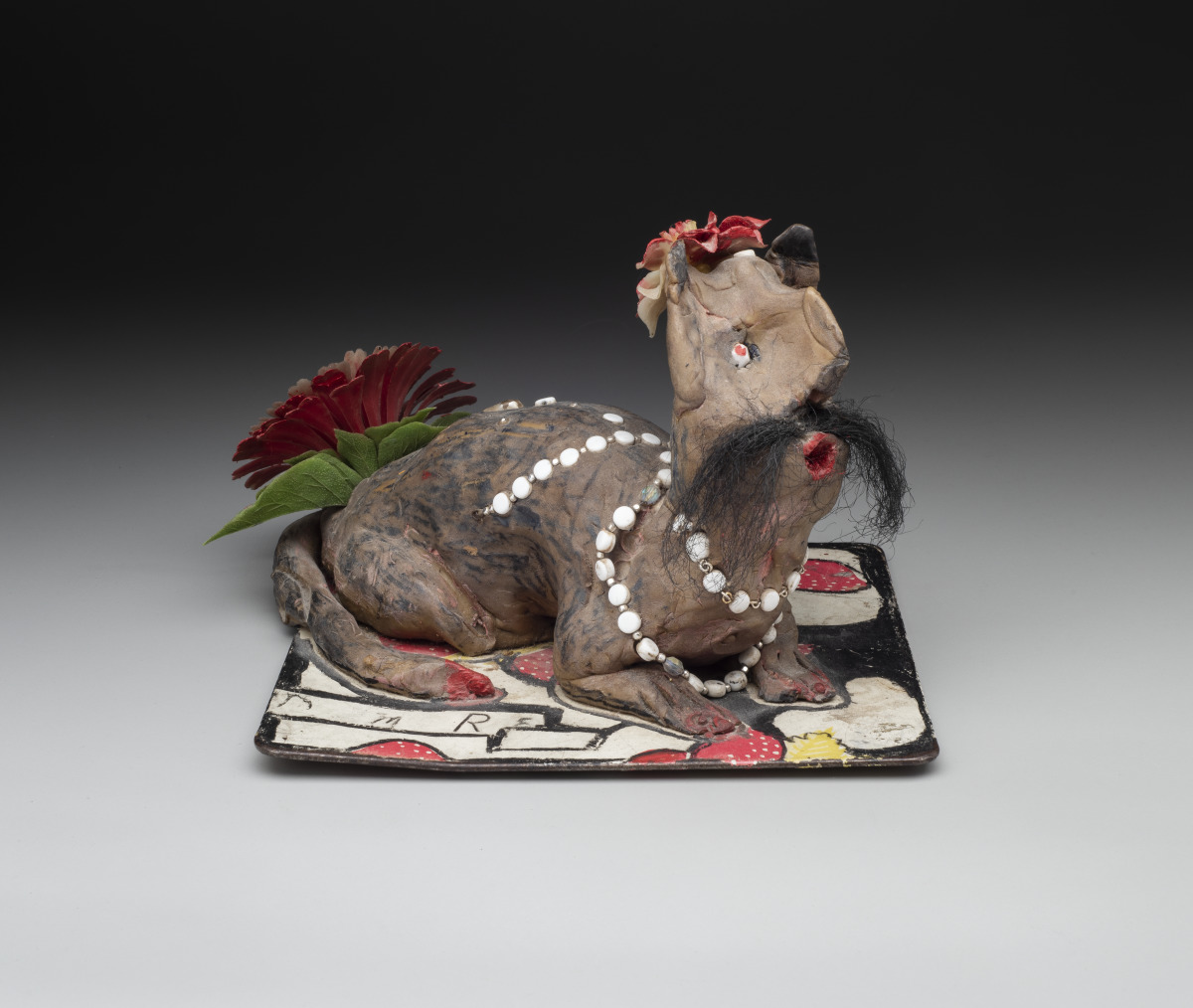Experimentation

Nellie Mae Rowe (American, 1900–1982), Untitled (Smiling Woman) (detail), before 1978, crayon and pencil on Sara Lee pound cake lid, 4 1/2 × 10 1/2 inches, gift of Judith Alexander, 2003.160. © Estate of Nellie Mae Rowe/High Museum of Art, Atlanta
By Katherine Jentleson
While the High has a work that is dated to 1947, Rowe said that she only began drawing in earnest in the late 1960s, by which time she was living alone and no longer working for her longtime employers. In many of her earliest works, Rowe drew on pieces of cardboard, recycled paper, and other surfaces that were close enough to flat, including a fabric bolt, shoeboxes, and pancake mix lids.
Rowe’s embrace of cast-off materials was grounded not only in the circumstance of scarcity but in a belief in the reuse of materials that has defined the practice of so many artists—trained and untrained—who began making art from everyday objects in the 1900s. Rowe was proud of her ability to transform things that other people discarded, saying, “When other people have something they don’t know what to do with they throw it away. But not me, I’m gonna make something.”
Once Rowe gained access to more paper and pigments from Judith Alexander, the gallerist who began representing her in 1978, her compositions became larger, more colorful, and more complex. She did not plan out her work, instead relying on a free-form process that artists earlier in the century called “automatic drawing” and which she called “following her line.” The sequences of early and later drawings in this section underscore how she moved from focusing on a single figure to complex decentralized compositions comprising flowing and fitting parts.
Citation
Jentleson, Katherine. Really Free: The Radical Art of Nellie Mae Rowe, wall text. High Museum of Art, Atlanta, September 3 2021–January 9, 2022. https://link.rowe.high.org/ essay/experimentation/.
“When other people have something they don’t know what to do with they throw it away. But not me, I’m gonna make something.”
-

Chewing gum was a way Rowe had been advised to treat ongoing headaches, which she called “the jumping in her head”; she kept what was left over, kneaded it into creature shapes, and chilled them in the freezer. Their once minty smell is something that artist Betye Saar, who visited Rowe after seeing one of her works at the California Museum of Art and Craft in the late 1970s, still remembers.
Untitled (Chewing-Gum Sculpture)
Nellie Mae Rowe, American, 1900–1982
before 1978
Chewing gum, plastic flowers, marker, plastic beads, and hair on trivet
9 1/2 x 5 1/2 x 6 inches
Gift of Judith Alexander
2001.7 -

Rowe used a flattened shoebox as the backdrop for a display of casual snapshots that an unidentified visitor took of the decorated interior and exterior of her home, which she called her Playhouse. The shoebox’s design sets off the visual of the patterned textiles and objects that Rowe, seen in the middle-left image, spread and hung throughout her space. In the bottom-left photograph, two of her sculptures made from chewing gum are visible, including a mustachioed cat much like Untitled (Chewing-Gum Sculpture) on view here.
Untitled (DeMura Shoebox Collage)
Nellie Mae Rowe, American, 1900–1982
before 1978
Color photographs on flattened shoebox
18 1/2 x 13 inches
Gift of Judith Alexander
2003.234 -

Rowe’s earlier memories of making art included the dolls she created for the amusement of herself and her siblings. This doll is atypical, standing apart from the others seen later in the show, because of how she crocheted its body. The indigo-blue yarn and magenta fabric she chose for it matches the vibrant color schemes she favored in her later drawing.
Untitled (Blue and Pink Doll)
Nellie Mae Rowe, American, 1900–1982
before 1978
Cloth, yarn, fiber stuffing, acrylic wig, and buttons
21 x 8 x 8 inches
Gift of Judith Alexander
2003.243 -

For inspiration, Rowe tapped into her subconscious in ways that the Surrealists had given credence to decades earlier, copying visions as she remembered them from her dreams and engaging in automatic drawing. As she described it, “I may make a start with a straight mark, and it will come to me what I want to make.” The way she followed her line into mysterious forms, testing whether they could become a tree, an animal, an elaborately dressed person, can be seen clearly in these two works, one an early experiment and the other a dramatically more detailed—but no less fluid—composition.
Untitled (Something that Ain’t Been Born Yet)
Nellie Mae Rowe, American, 1900–1982
1978
Crayon and pencil on ledger paper
14 x 9 inches
Gift of Judith Alexander
2003.218 -

Untitled (The Angel and the Devil’s Boot)
Nellie Mae Rowe, American, 1900–1982
1978
Crayon, pen, and pencil on cardboard
20 x 30 inches
Promised gift of Harvie and Charles Abney
PA.FOL.NMR3 -

Rowe said she drew a little here and there before her employers, the Smiths, were both deceased, and this work dates from that early period. The sorrowful blue figure at the picture’s center and his plea for mercy may be a tribute to her father, who passed away in 1945. Her second husband, Henry Rowe, died the following year and suffered from what may have been a form of dementia, so the work could also be an empathetic message for him.
Please Let Me Be
Nellie Mae Rowe, American, 1900–1982
1947
Marker and pencil on mounted book page
9 1/2 x 7 1/4 inches
Gift of Judith Alexander
2003.222

